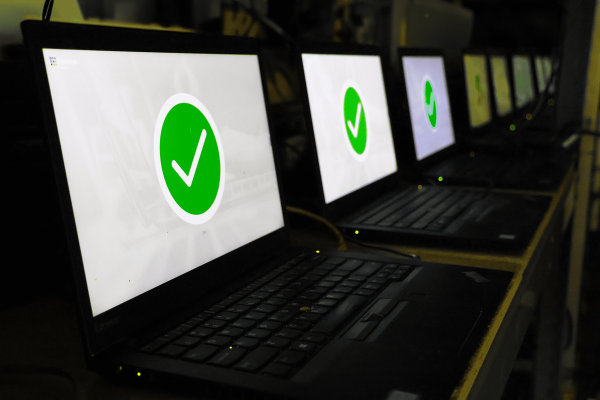Overview of Remote Work Trends
Rise in Remote Work Due to Technology Advancements and Global Events
The trend of remote work has surged in recent years, driven by technological advancements and global events such as the COVID-19 pandemic. As businesses adapt to these changes, the need for efficient remote IT asset management becomes crucial. Managing IT assets remotely ensures that employees have the necessary tools to work effectively, regardless of their location.
Importance of Managing IT Assets Efficiently for Remote Employees
Effective remote IT asset management is essential for maintaining productivity, security, and cost-efficiency. With a growing remote workforce, businesses must develop strategies to manage their IT assets seamlessly. This includes tracking, retrieving, and redeploying equipment to ensure all employees are well-equipped to perform their tasks.
Importance of Remote IT Asset Management

Ensuring Security, Efficiency, and Cost-Effectiveness
Remote IT asset management is vital for ensuring security, efficiency, and cost-effectiveness. Proper management helps prevent data breaches, optimize asset utilization, and reduce unnecessary expenses. By maintaining accurate records and implementing robust management practices, companies can protect sensitive information and make informed decisions about asset allocation.
Challenges Unique to Remote Setups Compared to Traditional Office Environments
Remote work environments present unique challenges for IT asset management. Unlike traditional office setups, remote work involves managing a dispersed workforce, which complicates asset tracking and retrieval. Companies must address issues such as varying internet reliability, different time zones, and the logistical complexities of shipping and receiving equipment across multiple locations.
IT Asset Retrieval for Remote Employees
Challenges of Retrieving IT Assets
Geographic Dispersion of Employees
One of the primary challenges in remote IT asset management is the geographic dispersion of employees. With team members spread across different regions or even countries, retrieving IT assets can be logistically challenging and costly. Companies need to develop efficient processes to handle the retrieval of equipment from various locations.
Potential Delays and Costs Associated with Shipping
Shipping delays and costs are significant concerns in remote IT asset management. The process of returning equipment can be time-consuming and expensive, especially when dealing with international shipments. Businesses must factor in these potential delays and costs when planning their asset retrieval strategies to minimize downtime and maintain operational efficiency.
Best Practices for Initiating Asset Retrieval for Remote Employees
Clear Policies and Communication Channels
Establishing clear policies and communication channels is crucial for effective remote IT asset management. Companies should have well-defined procedures for asset retrieval, including guidelines for employees on how to return equipment. Clear communication ensures that all parties understand their responsibilities and the steps involved in the retrieval process.
Scheduled Retrieval Processes
Implementing scheduled retrieval processes can streamline remote IT asset management. By planning and scheduling asset retrievals in advance, companies can coordinate logistics more efficiently and reduce the risk of lost or delayed equipment. Regularly scheduled retrievals also help maintain up-to-date asset inventories and ensure timely redeployment.
Logistics and Coordination

Collaboration with Logistics Partners
Collaboration with reliable logistics partners is essential for efficient remote IT asset management. Partnering with reputable shipping and courier services can help ensure the secure and timely transport of IT assets. Companies should work closely with their logistics partners to coordinate pickups, track shipments, and manage any issues that arise during the retrieval process.
Cost-Effective and Timely Solutions
Implementing cost-effective and timely solutions is a key aspect of remote IT asset management. Businesses should explore various shipping options and negotiate rates to minimize costs while ensuring timely delivery. Additionally, leveraging technology for real-time tracking and inventory management can enhance efficiency and reduce the overall expenses associated with asset retrieval.
Ensuring Data Security During Retrieval
Data Wipe Procedures Before Shipping
Ensuring data security is a critical component of remote IT asset management. Before shipping IT assets for retrieval, companies should implement robust data wipe procedures to protect sensitive information. Secure data wiping ensures that no confidential data remains on the devices, mitigating the risk of data breaches during transit.
Secure Packaging and Transit Methods
Using secure packaging and transit methods is vital for protecting IT assets during retrieval. Companies should invest in high-quality packaging materials and follow best practices for securing devices. Additionally, choosing reliable shipping services that offer tracking and insurance options can further safeguard the assets and ensure their safe return.
Importance of Tracking IT Assets for Remote Employees
Maintaining Inventory Accuracy
In remote IT asset management, maintaining inventory accuracy is paramount. Accurate inventory records ensure that all IT assets are accounted for, which is crucial for both operational efficiency and financial management. Keeping precise records helps avoid discrepancies that can lead to lost or misplaced equipment, ultimately saving time and resources.
Preventing Loss and Unauthorized Use
Preventing loss and unauthorized use of IT assets is a critical aspect of remote IT asset management. By tracking IT assets meticulously, companies can reduce the risk of theft, misplacement, or misuse of equipment. Proper tracking ensures that assets are only used by authorized personnel and are returned promptly when no longer needed.
Tools and Software for Asset Tracking
Overview of Popular IT Asset Management (ITAM) Tools
Utilizing IT asset management (ITAM) tools is essential for effective remote IT asset management. Popular ITAM tools such as Asset Panda, Snipe-IT, and Ivanti offer comprehensive solutions for tracking and managing IT assets. These tools provide a centralized platform for monitoring asset status, location, and usage, making it easier to manage assets remotely.
Features to Look for: Real-Time Tracking, Automated Updates, etc.
When selecting ITAM tools for remote IT asset management, it’s important to look for features like real-time tracking and automated updates. Real-time tracking allows companies to monitor assets continuously, providing immediate visibility into asset location and status. Automated updates ensure that the asset database is always current, reducing the risk of errors and omissions.
Establishing a Tracking Process
Initial Asset Assignment and Documentation
A well-structured tracking process begins with initial asset assignment and documentation. In remote IT asset management, it’s crucial to document every detail about each asset, including serial numbers, assigned user, and location. This initial documentation serves as the foundation for ongoing tracking and management.
Continuous Monitoring and Updates
Continuous monitoring and updates are essential for maintaining the accuracy of IT asset records. Implementing regular check-ins and updates ensures that any changes in asset status or location are promptly recorded. This ongoing process is vital for keeping the asset management system up-to-date and reliable.
Regular Audits and Updates
Periodic Checks to Ensure Asset Data Accuracy
Conducting periodic checks is a best practice in remote IT asset management. Regular audits help verify the accuracy of asset data, identifying any discrepancies or issues that need to be addressed. These checks are crucial for maintaining the integrity of the asset management system and ensuring that all records are accurate.
Procedures for Updating Asset Statuses
Establishing clear procedures for updating asset statuses is essential in remote IT asset management. These procedures should outline the steps for recording changes in asset location, condition, or ownership. Consistent and accurate updates ensure that the asset management system reflects the current status of all IT assets, facilitating better decision-making and resource allocation.
Benefits of Redeploying IT Assets

Cost Savings Through Reuse
One of the primary benefits of remote IT asset management is the cost savings achieved through the reuse of IT assets. By redeploying existing equipment instead of purchasing new devices, companies can significantly reduce their IT expenditures. This approach maximizes the lifespan of each asset, ensuring that investments are fully utilized.
Environmental Benefits of Reducing E-Waste
Remote IT asset management also offers substantial environmental benefits by reducing e-waste. Redeploying IT assets minimizes the need for new equipment production, thereby decreasing the volume of electronic waste that ends up in landfills. This practice supports sustainable business operations and promotes environmental responsibility.
Steps for Preparing Assets for Redeployment
Inspection and Assessment of Returned Assets
The first step in preparing IT assets for redeployment in remote IT asset management is a thorough inspection and assessment. Returned assets should be carefully examined to determine their condition and functionality. This assessment helps identify any necessary repairs or upgrades before the assets can be redeployed.
Refurbishment and Repair Processes
After the initial assessment, the next step in remote IT asset management is the refurbishment and repair of IT assets. This process involves fixing any hardware issues, replacing damaged components, and upgrading software as needed. Proper refurbishment ensures that the assets are in optimal condition for their next use.
Sanitization and Refurbishment Processes
Data Sanitization Standards and Practices
Data sanitization is a critical aspect of remote IT asset management. Before redeployment, all data on the IT assets must be securely erased to protect sensitive information. Implementing industry-standard data sanitization practices ensures that no residual data remains on the devices, mitigating the risk of data breaches.
Physical Refurbishment: Cleaning, Repairing, Upgrading
Physical refurbishment is essential for preparing IT assets for redeployment. This process includes cleaning the devices, repairing any physical damage, and upgrading components to meet current technological standards. Proper refurbishment enhances the performance and reliability of the redeployed assets.
Strategies for Efficient Redeployment
Matching Assets to New Users’ Needs
An effective strategy in remote IT asset management is matching redeployed assets to the specific needs of new users. By aligning the capabilities of the assets with the requirements of their new users, companies can ensure optimal utilization and productivity. This targeted redeployment approach maximizes the value of each asset.
Scheduling and Logistics for Redeployment
Scheduling and logistics are crucial components of efficient remote IT asset management. Companies should plan the redeployment process meticulously, considering factors such as asset availability, user requirements, and shipping logistics. A well-coordinated redeployment schedule minimizes downtime and ensures that assets are delivered to the right users at the right time.
Importance of Efficient IT Asset Management
Efficient remote IT asset management is vital for maintaining productivity, security, and cost-effectiveness. By implementing best practices for retrieval, tracking, and redeployment, companies can manage their IT assets effectively in a remote work environment.
Key Takeaways for Retrieval, Tracking, and Redeployment
- Retrieval: Establish clear policies, coordinate logistics, and ensure data security.
- Tracking: Use ITAM tools, maintain accurate records, and conduct regular audits.
- Redeployment: Inspect and refurbish assets, sanitize data, and plan logistics carefully.
The future of remote IT asset management will be shaped by emerging technologies like IoT, AI, and blockchain, enhancing asset tracking, security, and efficiency. As remote work evolves, adapting to new technological advancements and regulatory requirements will be essential. For all your remote IT asset management needs, contact Monmouth Wire Computer Recycling. Our expert team offers comprehensive solutions for retrieval, tracking, and redeployment, ensuring your IT assets are managed efficiently and securely. Visit our website to learn more about our services and how we can support your business.

